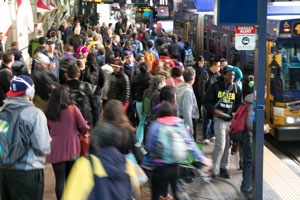Reducing service and making the most of every transit dollar
August 1, 2014
After action by the King County Council last week, Metro is moving forward with fall service reductions that are necessary to bring our service in line with available funding.
Here's a look at what's ahead for cuts, our ongoing efforts to make up for lost revenue and preserve as much service as we can, and some good news about ridership.

Service reductions set for Sept. 27
Consistent with principles expressed by County Executive Dow Constantine — don't spend money we don't have, and use objective criteria to make decisions on saving or cutting service — the County Council approved the reduction of 161,000 hours of bus service this September.
The Council also approved a reduction of 188,000 service hours in February 2015, but put off adopting specific route reductions or revisions pending further analysis by an ad hoc committee. We expect to submit an updated proposal to the Council on Sept. 2.
Decisions about additional service reductions will be made as part of the 2015-2016 budget process this fall. Following our service guidelines, we'll cut the least productive routes and trips in the first round of cuts.
Make no mistake: cutting service is our last resort. With the support of County leaders, we pulled out all the stops to keep buses on the road over the past six years. We cut costs, raised fares and other revenue, and dug deeply into reserves. But after the expiration of temporary funding this year and the lack of a transportation funding solution, we can no longer avoid cutting service.
I assure you, we're pursuing every opportunity to stretch our dollars to make up for lost revenue and preserve as much service as we can. This week, for example, some of our national peer transit agencies reviewed Metro's services and programs to make sure we're following industry best practices and to identify possible areas for improvement. We look forward to their advice.
We're also developing our Community Mobility Contracts program. Initiated by Executive Constantine, this program allows cities and others to "buy back" service planned for reduction or purchase new service.
Ridership growth continues — led by RapidRide

The importance of preserving as much service as we can is underscored by Metro's strong ridership growth this year.
Ridership has surpassed projections on RapidRide — a service the Executive has championed as part of the answer to rising transit demand. RapidRide's frequent all-day service is attracting thousands of riders and reducing traffic congestion and emissions on some of our region's most heavily used corridors.
Through June of this year, the total number of passenger trips on our six RapidRide lines has grown 39 percent above the routes the lines replaced. Ridership on the E Line, launched in February, has already grown 16 percent above the predecessor route. The F Line is off to a roaring start, with 23 percent more passengers in its first month of service.
Overall, Metro's ridership increased 1.7 percent in the first half of 2014. That's on top of a total 8 percent increase over the four previous years. Last year's 2.8 percent ridership increase outpaced King County's 1.3 percent population growth, and an all-time high 45 percent of households had at least one Metro rider.
Those stats translate into fewer greenhouse-gas emissions, less-congested traffic, and support for a strengthening economy — good reasons why we'll keep working to replace lost revenue and serve as many people as we can.
Read a news release from Executive Constantine »
Sincerely,
Kevin Desmond, General Manager
King County Metro Transit
Rob Gannon
General Manager, King County Metro Transit

If you live in King county, Metro is your public transportation system. I want you to know about our performance and the innovative service improvements we’re bringing your way.
Visit here often to read my newsletter, or sign up to receive it by e-mail.

